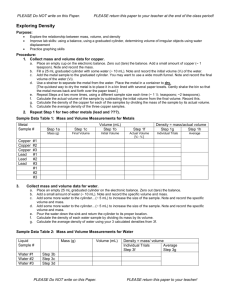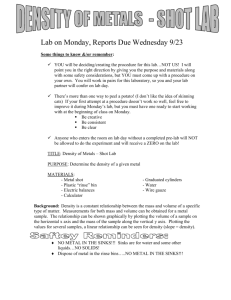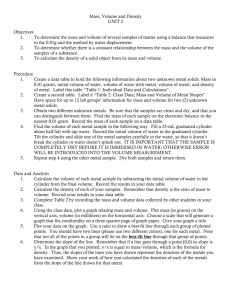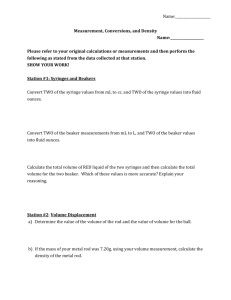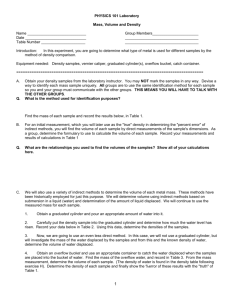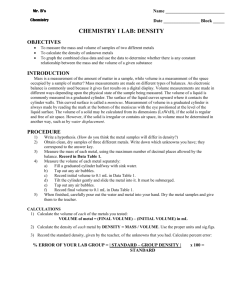Density of Metals Lab
advertisement
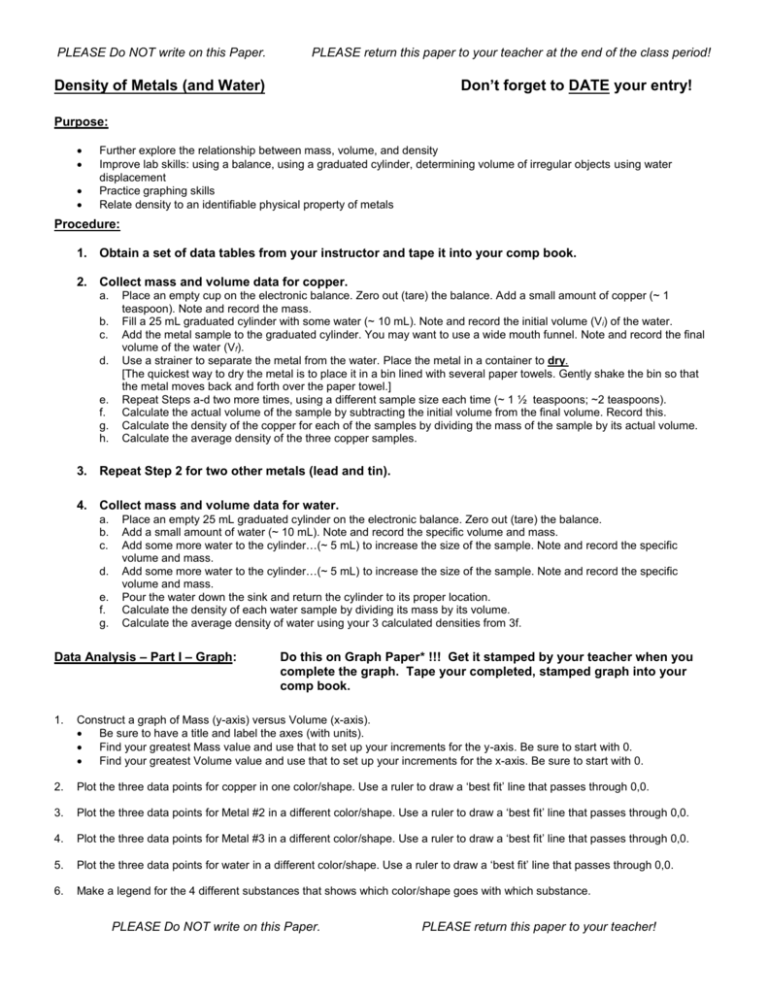
PLEASE Do NOT write on this Paper. PLEASE return this paper to your teacher at the end of the class period! Don’t forget to DATE your entry! Density of Metals (and Water) Purpose: Further explore the relationship between mass, volume, and density Improve lab skills: using a balance, using a graduated cylinder, determining volume of irregular objects using water displacement Practice graphing skills Relate density to an identifiable physical property of metals Procedure: 1. Obtain a set of data tables from your instructor and tape it into your comp book. 2. Collect mass and volume data for copper. a. b. c. d. e. f. g. h. Place an empty cup on the electronic balance. Zero out (tare) the balance. Add a small amount of copper (~ 1 teaspoon). Note and record the mass. Fill a 25 mL graduated cylinder with some water (~ 10 mL). Note and record the initial volume (Vi) of the water. Add the metal sample to the graduated cylinder. You may want to use a wide mouth funnel. Note and record the final volume of the water (Vf). Use a strainer to separate the metal from the water. Place the metal in a container to dry. [The quickest way to dry the metal is to place it in a bin lined with several paper towels. Gently shake the bin so that the metal moves back and forth over the paper towel.] Repeat Steps a-d two more times, using a different sample size each time (~ 1 ½ teaspoons; ~2 teaspoons). Calculate the actual volume of the sample by subtracting the initial volume from the final volume. Record this. Calculate the density of the copper for each of the samples by dividing the mass of the sample by its actual volume. Calculate the average density of the three copper samples. 3. Repeat Step 2 for two other metals (lead and tin). 4. Collect mass and volume data for water. a. b. c. d. e. f. g. Place an empty 25 mL graduated cylinder on the electronic balance. Zero out (tare) the balance. Add a small amount of water (~ 10 mL). Note and record the specific volume and mass. Add some more water to the cylinder…(~ 5 mL) to increase the size of the sample. Note and record the specific volume and mass. Add some more water to the cylinder…(~ 5 mL) to increase the size of the sample. Note and record the specific volume and mass. Pour the water down the sink and return the cylinder to its proper location. Calculate the density of each water sample by dividing its mass by its volume. Calculate the average density of water using your 3 calculated densities from 3f. Data Analysis – Part I – Graph: Do this on Graph Paper* !!! Get it stamped by your teacher when you complete the graph. Tape your completed, stamped graph into your comp book. 1. Construct a graph of Mass (y-axis) versus Volume (x-axis). Be sure to have a title and label the axes (with units). Find your greatest Mass value and use that to set up your increments for the y-axis. Be sure to start with 0. Find your greatest Volume value and use that to set up your increments for the x-axis. Be sure to start with 0. 2. Plot the three data points for copper in one color/shape. Use a ruler to draw a ‘best fit’ line that passes through 0,0. 3. Plot the three data points for Metal #2 in a different color/shape. Use a ruler to draw a ‘best fit’ line that passes through 0,0. 4. Plot the three data points for Metal #3 in a different color/shape. Use a ruler to draw a ‘best fit’ line that passes through 0,0. 5. Plot the three data points for water in a different color/shape. Use a ruler to draw a ‘best fit’ line that passes through 0,0. 6. Make a legend for the 4 different substances that shows which color/shape goes with which substance. PLEASE Do NOT write on this Paper. PLEASE return this paper to your teacher! PLEASE Do NOT write on this Paper. PLEASE return this paper to your teacher at the end of the class period! Data Analysis – Part II – Questions: Answer these in your Chemistry comp book. Answer using complete thoughts or properly labeled math equations. Remember – you get to use this information on the test… record enough information that your answers make sense to you! 1. What does your graph show you? 2. Define the term ‘precision’. 3. Look at your lab data. For which substance is the data the most precise? Explain. 4. Define the term ‘accuracy’. 5. Record the ‘published’ densities of the three metals and water. (Your teacher may provide these or will refer you to a resource.) 6. What is the formula for determining percent error? 7. Calculate the percent error for the density of each metal and water. Show your work. Circle your answers. 8. Which substance had the highest percent error in its measured density? Make a claim including specific evidence… then explain one reason why you think this value was not very accurate. 9. What does the slope of each line on your graph represent? 10a. Using the graph, calculate the density of the substance with the steepest slope. Show your work ! Circle your answer. [Remember Slope = rise/run or y/x Pick 2 points on your graph that are ‘conveniently placed’. Use these to determine slope. Or if you have the equation of the line of best fit (y=mx + b), you can simply record the slope of the line (m).] 10b. Is this value more or less accurate than the average value for the density you calculated in Step 1g? Explain. Conclusion : RESPOND ON AN INDEX CARD and turn it in to your teacher. Be sure to include name, date, pd. You will get this index card back, so leave room for it in your comp book. Write a short summary paragraph of what your graph shows you using the terms…. density, slope, sink, float, water, copper, lead, _______ (the other metal your group tested). Making Connections: 1. Compare the data tables you made for the density of dice lab with the data tables your teacher made for this lab. Note similarities and differences. Identify the characteristics of a quality scientific data table. 2. How does the density of your dice compare to the density of the three metals in this lab? How about water? Where would a line representing the density of dice appear on your graph? Sketch this line in. 3. The density of vegetable oil is generally reported to be around 0.92 g/mL. Where would a line representing the density of vegetable oil appear on your graph? Sketch this line in. 4. EXTRA CREDIT – Look up the densities of the metals found in columns 1 and 2 on the periodic table. Record them and make note of any patterns…. Make a claim, cite your evidence, and describe a reasonable science (chemistry ) explanation for your claim. When you turn this in, please include the source of your information !!! PLEASE Do NOT write on this Paper. PLEASE return this paper to your teacher!

